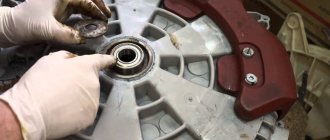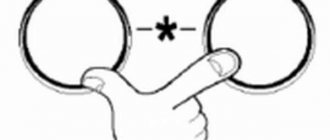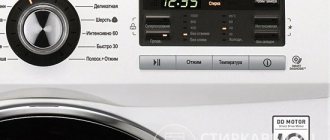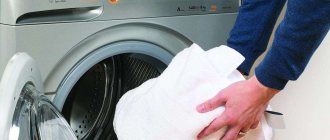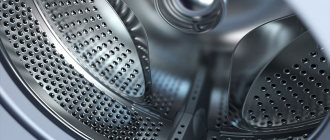Let's consider replacing the bearing on the LG washing machine with your own hands at home. LG brand SMAs have proven themselves to be reliable and unpretentious, while having a stylish design that many consumers like. But even such washing machines are prone to breakdowns. One of them is wear on the drum bearings. And as a result - increased noise during spinning, sometimes becoming so loud that further operation becomes unbearable. In this case, replacement is necessary.
Expert opinion
I work in the household appliance repair industry. Extensive experience in restoring washing machines and dishwashers.
Ask a Question
Wear can be determined by significant play of the drum in different directions. Quite often in this case the belt begins to fly off if the machine is not equipped with a direct drive motor. If you wish and have the necessary tools, you can actually carry out such repairs yourself at home. To do this you need to remove the bearing.
- Preparation for repair
- Disassembling the LG washing machine
- Replacing bearings
- Assembling an LG washing machine
- Video
- Catalog of LG washing machines
Preparation for repair
Please note that sufficient space is required to complete the work. You will have to completely disassemble the car, removing additional equipment. Then you will need to take out the tank, divide it and pull out the drum. Please consider these points before starting repairs.
Repaired washing machine
Important! First of all, we disconnect the machine from electricity and sewerage. We also disconnect the inlet hose, having first shut off the water supply through it to avoid flooding.
The work will be carried out on an Ldzhi washing machine with a Direct Drive system with a 7 kg load of laundry. This model has a steam cycle, but this does not affect anything. You just have to dismantle the additional element. The device of other models is the same.
We prepare the tools:
- Slotted, Phillips, and Torx screwdrivers.
- Pliers.
- Wire cutters.
- Hammer.
- Punch.
- Ratchet socket wrenches.
- Penetrating lubricant like WD-40.
Possible difficulties
Difficulties that may arise when replacing bearings in an LG washing machine:
- If there is a feeling that when knocking out the bearing it does not come out or moves out unevenly, the cover must be turned over and the actions on the reverse side must be corrected.
- If the bearing wear is significant, this can lead to wear on the cover. In this case, it will have to be replaced.
- To avoid damaging its integrity during the process of removing the cuff, the clamp must be removed carefully.
- Sometimes some water remains in the hoses and tubes. You need to be careful not to get it on the electronics.
Replacing bearings
Note that there are specialized bearing pullers. But the cost of such a mechanism is: 4-5 thousand rubles. There is no practical sense in purchasing them for one-time repairs. Therefore, we use a hammer and a metal drift, which can be a chisel. This is the best option.
Let's start with the oil seal. We pry it off with a strong screwdriver and pull it off. If it doesn’t work right away, then soak it in a penetrating lubricant.
Then we knock out the outer bearing. Place the tank on a stand and strike with a hammer, moving the drift in a circle. As a rule, this is the easiest dismantling.
Then remove the inner one in the same way. If difficulties arise, use VD-40. This procedure is quite loud, so it can be moved outside so as not to irritate the neighbors.
Important! When dismantling, it is allowed to hit the inner rim of the bearing. During installation - absolutely not!
Installed new bearing
We clean and dry the seat and begin installing the new repair kit. We carry out the work in reverse order. We install the oil seal last. Before installing it, apply lubricant to the skirt, as well as the internal spring. For convenience, we use old bearings, cleaned of oil and dirt. That is, we hit them. This will avoid distortion during installation.
It is recommended to fix the oil seal using glue or self-tapping screws.
After cleaning the tank, carefully inspect the shaft, especially the oil seal seat. LG is the only company that has this part made of stainless steel. If repairs are carried out a long time after the bearings begin to fail, this area may be damaged by rust. For small flaws, the situation can be corrected using fine sandpaper. If there is significant damage, then boring or seating of an additional ring is necessary. In this case, an oil seal with a different standard size is selected.
When does it need to be changed?
The following signs will indicate that it is time to replace the bearing in your washing machine
Extraneous noise that occurs during washing or while rinsing clothes. This may include metallic clanging, knocking and grinding sounds.- Poor quality spinning. Due to the destruction of the bearings, the drum does not pick up speed, so the laundry remains wet.
- Washing machine imbalance. When the drum rotates, it will sway violently from side to side.
- Damage to the edges of the cuff. This may serve as an indirect sign of bearing wear.
You can determine that it’s time to change a part even without disassembling the washing machine. To do this, just unplug it, place your hand on the top of the drum and swing it. It should move with the tank on the springs, but there should be no play between them. If there is free play, it means the bearing has begun to deteriorate.
Assembling an LG washing machine
Front Panel Installation
When connecting a tank, it is recommended to apply high-temperature plumbing silicone to the joint to eliminate possible leaks due to deformation of the rubber gasket.
All steps for assembling the washing machine are performed in reverse order and do not cause any difficulties.
Adviсe:
- When disassembling, you can photograph the stages sequentially.
- All screws and self-tapping screws are screwed back in. This will avoid confusion.
How much does a master's work cost?
If you cannot cope with replacing the bearing on your own, you should contact a specialist. You can find a specialist by looking at an ad in a newspaper or on the Internet. Another option is to contact a service center. If the machine is under warranty, the repairs must be paid for by the manufacturer of the household appliance.
In a workshop, bearings are inserted using a special press, so it will be installed efficiently and will not fly out of the socket. The cost of repair work starts from 3,300 rubles.
To minimize the risk of encountering scammers, you need to contact trusted professionals or large service centers with a positive reputation. You also need to check with a specialist in advance how much the repair will cost.
Stage 6. Freeing the tank from fasteners
After removing the front wall, access to all elements of the washing machine opens. Disconnect from the tank;
- pipelines to the filling valve;
- pipe to the drain pump;
- rotor and wires to the stator (in direct drive models);
- wires going to the heating element, temperature sensor and electric motor;
- drainage pump wiring;
- pressure sensor pipe.
We also dismantle both counterweights (larger in the upper part of the washer and smaller in the lower) and shock absorber mounts. After this, unhook the springs and pull the tank out of the washing machine body.
Step-by-step execution
Before you begin, familiarize yourself with the diagram and procedure for disassembling the LG washing machine.
The only difference between LG machines is the presence of direct drive, which must be taken into account when dismantling.
Do-it-yourself disassembly of an LG washing machine begins with removing the panels.
Top cover
Using a Phillips screwdriver, go to the back panel and remove the two screws from the top that hold the top panel in place. Keep the bolts in one place so they don't get lost. Now, slide the cover forward a little, remove it from the body and set it aside.
Back cover
In modern models of ElG washing machines there is a service hatch at the back. It is closed with a metal cover, which is held on by bolts. Unscrew the bolts around the perimeter of the hatch, remove and set aside. You now have access to the internal parts of the SM.
Control Panel
To remove the panel, you need to pull out the detergent dispenser tray. Pull it towards you while pressing the latch in the center. Just behind the tray you will see three screws. Unscrew them, as well as one screw on the opposite side, with a Phillips screwdriver.
Front Panel
How to remove the front cover of an LG washing machine:
- Open the hatch door.
- Bend the edge of the hatch cuff at the base.
- You will see a metal clamp. It can be removed by slightly prying it with a flathead screwdriver. The manufacturer has provided a simple and convenient spring clamp, so removing it will not be difficult.
- Tuck the edges of the sealing rubber (cuff) inside the drum.
- Open the filter hatch.
- Unscrew the fixing bolts located near the filter.
- Unlock the latches of the bottom panel and move it to the side.
- Return to the hatch. Remove the two bolts holding the door lock.
- Place your hand behind the body and pull out the lock. Disconnect all wires from it and remove.
- Remove all the screws at the top and bottom that hold the front panel in place.
- Remove and set aside.
Counterweights
Counterweights weigh down the tank, preventing it from hitting the walls during vibration. Once you remove the panel, you will see two counterweights around the CMA hatch.
To remove them, unscrew the bolts using a Torx socket. You are already on your way to completely disassembling your LG machine. Also remove the top counterweight.
Main details
Now you need to disconnect all the parts that are located on top of the tank.
To remove the dispenser tray hopper, unscrew the screws on top and disconnect the pipe coming from the bottom. Disconnect the inlet valve contacts. To remove the valve, unscrew the two screws at the back. Pull out the hopper along with the valve.
Let's disassemble the LG washing machine further: disconnect the pressure switch hose leading to the tank. Inspect the tank, check connections, parts that may prevent it from being removed. If you have disconnected everything, move down the case.
Removing the engine
First you need to disconnect the drain pipe. Using pliers, loosen the metal pipe clamp and disconnect it. Sometimes these clamps are secured with a bolt that needs to be removed.
Unclench the connectors of the wires leading to the heating element. It is not necessary to take out the heating element itself. Before disassembling the LG washing machine, remove the motor:
- Remove the motor cover by unscrewing the central screw.
- You will see six more mounts located on the engine.
- Remove all bolts.
Once you remove the engine, there is nothing holding the tank in the back except the struts.
Racks
The SM posts are secured with plastic rods. Take a 14mm socket, bring it to the back of the post and slide it onto the bolt. This will disable the latches that would otherwise prevent the stem from being reached.
Use pliers to grab the edge of the rod, pull it towards you and remove it.
Now let's look at how to remove the drum and tub in an LG washing machine.
Methods for determining failure
First of all, you need to determine what kind of breakdown occurred. An initial diagnosis will help you decide whether it is possible to fix the problem yourself or whether you will still have to spend money on professional repairs.
The right step would be to first familiarize yourself with the circuit diagram of the washing machine in order to have an idea of where everything is located.
In many cases, a breakdown in the Indesit washing machine can be repaired with your own hands. But to do this, you at least need to familiarize yourself with the design of the machine.
Sometimes, to determine the cause of the failure of household appliances, it is enough to read the instructions for use, which, among other things, contain recommendations for eliminating breakdowns.
The first thing you need to do is look at the display. If it is impossible to complete the specified process, the washing machine displays special codes on the display.
Models of Indesit washing machines produced in recent years are equipped with displays, the signals of which will be the first to report the occurrence of a malfunction
Error codes in the operation of the washing machine are given in the instructions that the manufacturer necessarily attaches to its product:
- F01 – in the control of the drive motor the triac semiconductor device is closed;
- F02 - due to an open circuit or short circuit, the tachogenerator has lost the ability to signal the rotation of the drive motor, another reason for such an error is the motor is blocked;
- F03 – the temperature sensor circuit has been short-circuited or broken;
- F04 – failure of the water level sensor;
- F05 – due to an interruption in the operation of the drain pump, a clogged drain tract, or a malfunction of the water sensor, the “empty tank” signal is not given;
- F06 – due to errors in the front panel buttons, the program code is not defined;
- F07 – the heating element does not heat up;
- F08 – faulty wiring, relay or tubular electric heater itself;
- F09 – EEPROM memory has failed;
- F10 – the water level sensor suddenly lost signals of both a full and an empty tank;
- F11 – the supply voltage has disappeared in the drain pump;
- F12 – communication between the controller and the display module is broken;
- F13 – open or short circuit in the sensor circuit responsible for the drying temperature;
- F14 – malfunction in the drying heating element;
- F15 – damage to the heating element relay responsible for drying;
- F16 – drum blocking;
- F17 – power is not supplied to the hatch door lock or they forgot to close it;
- F18 – on the main electronic module there was a communication error between the controller chips and the processor that controls the asynchronous drive motor.
A complete explanation of error codes in the operation of Indesit washing machines and ways to eliminate violations will be provided in an article entirely devoted to these important issues.
It is possible to check various contacts, wiring, sensors using a very useful device - a multimeter. The device will show whether there is power everywhere.
If you have dealt with electrical repairs before and know how to use a multimeter, it will help clarify the situation and point out some errors
Sometimes it is enough to listen to the sound made by the unit. When the washing machine begins to creak, make excessive noise, and sometimes even rumble, then, most likely, problems have arisen in the bearings or drum, the oil seal is damaged, the counterweight fasteners are loose, and the shock absorbers are in poor condition.
